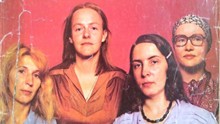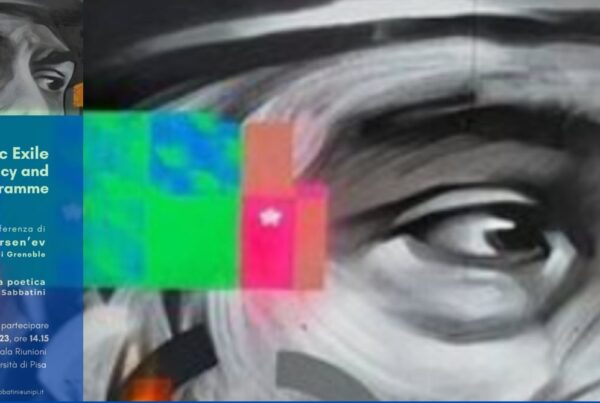
Maiakovskii square.
Dates: 1958 – 1961 approx.
Place: Moscow
Members: Iurii Galanskov, Vladimir Bukovskii, Vladimir Osipov, Anatolii Shchukin, Aleksandr Ginzburg, Bulat Okudzhava, Mikhail Kaplan, Apollon Shucht, Vladimir Vishniakov, Ėduard Kuznetsov, Sergei Chudakov, Alisa Gadasina, Alena Basilova and others
Description:
The long-awaited monument dedicated to Vladimir Maiakovskii, work of the sculptor Aleksandr Kibal’nikov, was inaugurated on 28th July 1958 in the square named after the writer, informally called “Maiakovka” and today known by its original name, Triumfal’naia. A public reading was organised under the poet’s statue, attended by some of the most famous literary figures of the time. The event was so well attended that at the end of the ceremony, additional readings were improvised by the crowd (cf. Bukovskii 1997: web). The authorities took a lenient stance and did not intervene but in the weeks and months that followed, the situation got out of control and the original event, organised from above, transformed into a spontaneous, communal ritual involving poets, writers, artists, campaigners for greater freedom of expression and passers-by who met to read verses, hand-written by themselves or composed by forgotten poets of the past (the avant-garde and modernist works of the early twentieth century were popular). The gatherings took place during the most optimistic phase of the thaw, a phase that would soon come to an end, but at the time engendered genuine hope that was shared by almost everyone.
The most representative figure of the square, also called “The Lighthouse” (maiak in Russian), was Iurii Galanskov, a young man, whose talent as a poet was not as great as his charisma and magnetism which were always able to stir up the crowd. Galanskov was author of Chelovecheskii manifest (Human Manifesto), a programmatic poem encapsulating the spirit of Maiakovka (cf. Galanskov 1997: web). Decades later, those who listened to his verses at Maiakovka would recall the emotions they inspired, rather than judge their literary value (cf. Bukovskii 1997). As editor of the samizdat almanacs Feniks (1961) and Feniks 66 (1966), Galanskov is recognised not only as the Lighthouse’s driving force but also as one of the first human rights activists in the USSR. He died at the age of thirty-three in a labour camp, where he had been sent because of his political and literary activity.
Another famous participant of the evenings in Maiakovskii Square was Aleksandr Ginzburg, who was arrested for having printed three issues of the almanac Sintaksis. Similar fates fell to other Maiakovka habitué including Vladimir Bukovskii, Ėduard Kuznetsov and Vladimir Osipov. Osipov, who was later editor of the magazines “Bumerang” and “Veche”, was arrested on charges of plotting an attempt on Khrushchev’s life (cf. Parisi 2017: 197). It is not clear if the subversive plan was actually planned by some maiakovtsy or if it was invented by the authorities to put an end to the meetings.
The meetings organised around the base of Maiakovskii’s statue, a poet celebrated by the regime for his role as prophet of the Revolution and revered by young non-conformists for his futurist past and rebellious nature, periodically continued for a few years, greatly disturbing the authorities. Unable to use violence in times of ostentatious tolerance, they tried several times and in different ways to call the interested parties to order (cf. Bukovskii 1997: web). The chance to put an end to the meetings came on the day of the solemn celebrations for Gagarin’s space flight, the 14th of April 1961, which coincidentally was also the anniversary of Maiakovskii’s death. The young people of the Lighthouse chose to meet despite the official ban. The incident that sparked a clampdown was a fight, probably instigated by the police, involving dozens of people, including drunkards returning from the official ceremony and the police themselves, who managed to arrest Osipov and Shukin. The Maiakovka meetings ended that evening, even if the readings lasted for a few more months. The young people who had given rise to a protest very different from traditional and contemporary forms of Western protest (cf. Piretto 2001), poured into private flats, creating a new, more intimate form of dissent, free from illusion or desire for change.
The square itself would become in the following years a theatre for further expressions of dissent. On 14th April 1965, SMOG staged an artistic-literary protest and on the occasion of the funeral of Jan Palach, two schoolgirls, Ol’ga Ioffe and Irina Kaplun, displayed messages in support of Czechoslovakia. The two young women were arrested but soon released (cf. Parisi 2017: 198).
Federico Iocca
[June 30th, 2021]
Translation by Alice Bucelli
Bibliography
- Bukovskii V., Gaid-park po-sovetski, in L. Polikovskaia, “My predchustvie, predtecha…”. Ploshchad’ Mayakovskogo. 1958-1965, Zven’ia, Moskva 1997, http://old.memo.ru/history/diss/books/mayak/index.htm, online (last accessed: 30/06/2021).
- Galanksov Iu., Chelovecheskii manifest, in L. Polikovskaia, “My predchustvie, predtecha…”. Ploshchad’ Mayakovskogo. 1958-1965, Zven’ia, Moskva 1997, http://old.memo.ru/history/diss/books/mayak/index.htm, online (last accessed: 30/06/2021).
- Parisi V., Guida alla Mosca ribelle, Voland, Roma 2017.
- Piretto G. P., Il radioso avvenire: mitologie culturali sovietiche, Einaudi, Torino 2001.
To cite this article:
Federico Iocca, Maiakovskii square, in Voci libere in URSS. Letteratura, pensiero, arti indipendenti in Unione Sovietica e gli echi in Occidente (1953-1991), a cura di C. Pieralli, M. Sabbatini, Firenze University Press, Firenze 2021-, <vocilibereurss.fupress.net>.
eISBN 978-88-5518-463-2
© 2021 Author(s)
Content license: CC BY 4.0




